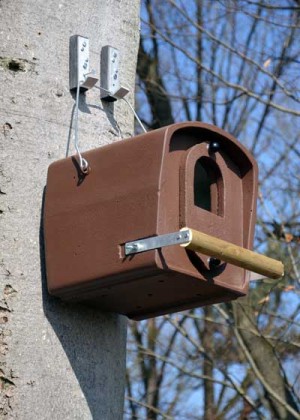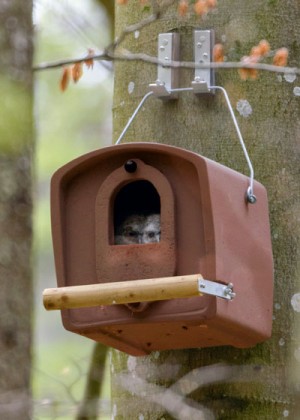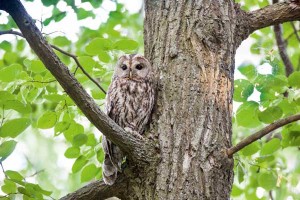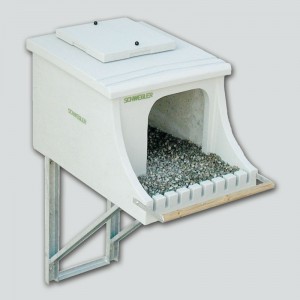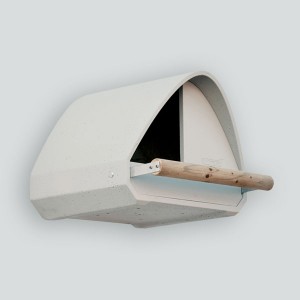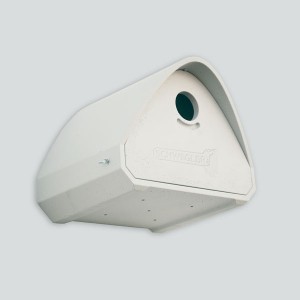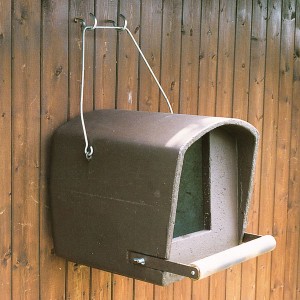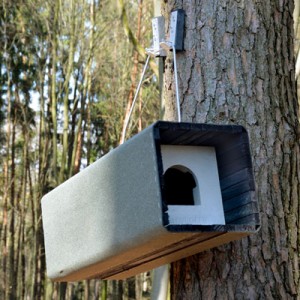The Tawny Owl (Strix aluco) is a native bird species and a member of the Owl family. Its average size is approx. 40 cm and it weighs between 500 and 600 grams. The females are somewhat larger and heavier than the males. They can be identified by their grey-brown, bark-coloured plumage. The large head of the silent hunter sits on a stout body. Its friendly appearance is thanks to its large round eyes in the framed light-coloured facial disc and the highly curved yellowish beak. It is a resident bird and stays almost its whole life long in the same territory. The life cycle can be up to 15 years.
The Tawny Owl is sexually mature with one year and the mating season begins in the autumn. Once a pair have found each other, it mostly stays together their whole life long. The pair has an annual breed, from February to April, depending on the weather, with two to six eggs. They are only brooded by the female and the blind young hatch out after approx. 30 days. A freshly hatched Tawny Owl weighs only around 28 grams. After four to five weeks, the young birds leave the nest. These so-called “branchers” then continue to be fed by both parents for around five weeks.
The food spectrum consists of Mice, Rats, Frogs, Earthworms and small mammals. At the age of five months there is hardly any difference in plumage between the old and young and the wingspan is then in its fully-grown state of approx. 100 cm. Only half the young birds survive the first year. Its German name “Waldkauz” (small forest owl) indicates its original habitat. It is most comfortable in open deciduous forests and mixed woodlands. If it can’t find a suitable tree hollow as a daytime hideaway or breeding cavity, it also accepts quiet places on buildings, barns, rocky ground and eagerly welcomes species-appropriate nest boxes and elongated breeding enclosures. But as natural and suitable breeding places become ever more scarce, this Owl species increasingly suffers from housing shortage. Monotonous forests (with small ratio of deadwood), parks and young managed forests in particular do not – or only conditionally – provide suitable breeding ground and daytime hideaways for the Tawny Owl.
Installation: It is advisable to install one to two nest boxes in an area of approx. 50 ha.
Natural prey: Hawks, Eagle Owls and disease.
Do not install: In the territories of Eurasian Pigmy Owls, Boreal Owls and Little Owls.
Tawny Owl Box No. 30
Material: SCHWEGLER Wood-Concrete Nest Box. Hanger: steel, galvanised.
Siting: forests, buildings, rock faces, etc.
Installation height: from 4 m to 6 m.
Entrance hole size: approx. 12 x 12 cm.
External dimensions: W 33 x H 36 x D 45 cm.
Brood chamber inside: W 30 x H 34 x D 30 cm.
Weight: approx. 14 kg.
Includes: Nest box, hanger, hook, two mounting blocks and bedding.
 English
English Deutsch
Deutsch 
